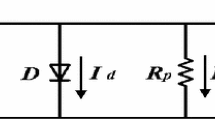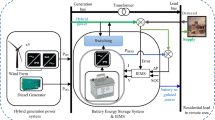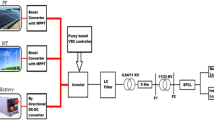Abstract
Electricity from renewable energy is certainly the most prominent alternative to deliver power to remote locations; however, its reliability is affected by the intermittency of the renewable source. A smart load technology called ‘electric spring (ES)’ can compensate for the intermittency and thereby maintain the voltage level constant for critical loads with an efficient and reliable control approach. This paper suggests wind energy-fed generation as the only and primary source for an isolated remote microgrid. The voltage level of the system remained unaltered by deploying a voltage source converter-based ES with a novel artificial neural network-based fuzzy controller. The novelty of the system is that it can operate significantly under varying load, variable torque, and varying wind speed conditions by exchanging power between critical and non-critical loads. Further simulation results ensure the credibility of the electric spring–artificial neural network-based fuzzy controller system in terms of stability and performance parameters such as settling time, rise time, and maximum overshoot. Additionally, the total harmonic distortion of the system is found to be well within the boundary of the acceptable range that proclaims its feasibility and applicability in a real-world scenario.

















Similar content being viewed by others
References
Amirat, Y., Benbouzid, M., Bensaker, B., & Wamkeue, R. (2007). The state of the art of generators for wind energy conversion systems. Electromotion, 14(4), 163–172.
Attuati, G., de Camargo, R. F., & Scherer, L. G. (2019). Proportional-resonant stator current controller applied to seig based systems. In 2019 IEEE PES innovative smart grid technologies conference-Latin America (ISGT Latin America) (pp. 1–6). IEEE.
Babu, N. R., & Arulmozhivarman, P. (2013). Wind energy conversion systems-a technical review. Journal of Engineering Science and Technology, 8(4), 493–507.
Beainy, A., Maatouk, C., Moubayed, N., & Kaddah, F. (2016). Comparison of different types of generator for wind energy conversion system topologies. In 2016 3rd international conference on renewable energies for developing countries (REDEC) (pp. 1–6). IEEE.
Bim, E., Szajner, J., & Burian, Y. (1989). Voltage compensation of an induction generator with long-shunt connection. IEEE Transactions on Energy Conversion, 4(3), 526–530.
Chinmaya, K. A., & Singh, G. K. (2018). Performance evaluation of multiphase induction generator in stand-alone and grid-connected wind energy conversion system. IET Renewable Power Generation, 12(7), 823–831.
Dorile, P. O., Jagessar, D. R., & McCann, R. A. (2021). Techno-economic assessment of voltage stability improvement using SSSC and STATCOM in a wind-dominated power system. In 2021 IEEE Kansas power and energy conference (KPEC) (pp. 1–6). IEEE.
Hui, S. Y., Lee, C. K., & Wu, F. F. (2012). Electric springs—A new smart grid technology. IEEE Transactions on Smart Grid, 3(3), 1552–1561.
Kumar, A., Chauhan, Y. K., & Shrivastava, A. (2019). Design, modeling and performance of static synchronous series compensator regulated self-excited induction generator. In 2019 3rd International conference on recent developments in control, automation & power engineering (RDCAPE) (pp. 519–525). IEEE.
Lee, C. K., Liu, H., Tan, S. C., Chaudhuri, B., & Hui, S. Y. R. (2020). Electric spring and smart load: Technology, system-level impact, and opportunities. IEEE Journal of Emerging and Selected Topics in Power Electronics, 9(6), 6524–6544.
Luo, X., Akhtar, Z., Lee, C. K., Chaudhuri, B., Tan, S. C., & Hui, S. Y. R. (2014). Distributed voltage control with electric springs: Comparison with STATCOM. IEEE Transactions on Smart Grid, 6(1), 209–219.
Pati, S., Mohanty, K. B., & Kar, S. K. (2018a). A sliding mode controller-based STATCOM for voltage profile improvement of micro-grids. World Journal of Engineering, 15(2), 283–291.
Pati, S., Mohanty, K. B., & Kar, S. K. (2018b). Performance improvement of a STATCOM using fuzzy controller for isolated generator. World Journal of Engineering.
Rai, H. C., Tandan, A. K., Murthy, S. S., Singh, B., & Singh, B. P. (1993). Voltage regulation of self excited induction generator using passive elements. In 1993 Sixth international conference on electrical machines and drives (Conference Publication No. 376) (pp. 240–245). IET.
Sandhu, G. S., & Rattan, K. S. (1997). Design of a neuro-fuzzy controller. In 1997 IEEE international conference on systems, man, and cybernetics. Computational cybernetics and simulation (vol. 4, pp. 3170–3175). IEEE.
Sekar, K. (2020). Power quality disturbance detection using machine learning algorithm. In 2020 IEEE International Conference on Advances and Developments in Electrical and Electronics Engineering (ICADEE) (pp. 1–5). IEEE.
Shoaib, M., Siddiqui, I., Rehman, S., Khan, S., & Alhems, L. M. (2019). Assessment of wind energy potential using wind energy conversion system. Journal of Cleaner Production, 216, 346–360.
Shridhar, L., Singh, B., Jha, C. S., Singh, B. P., & Murthy, S. S. (1995). Selection of capacitors for the self regulated short shunt self excited induction generator. IEEE Transactions on Energy Conversion, 10(1), 10–17.
Singh, B., Murthy, S. S., & Gupta, S. (2004). Analysis and design of STATCOM-based voltage regulator for self-excited induction generators. IEEE Transactions on Energy Conversion, 19(4), 783–790.
Singh, B., Murthy, S. S., & Chilipi, R. S. R. (2014). STATCOM-based controller for a three-phase SEIG feeding single-phase loads. IEEE Transactions on Energy Conversion, 29(2), 320–331.
Soni, J., Sen, B., Kanakesh, V. K., & Panda, S. K. (2018). Performance analysis and evaluation of reactive power compensating electric spring with linear loads. International Journal of Electrical Power & Energy Systems, 101, 116–126.
Tan, S. C., Lee, C. K., & Hui, S. Y. (2012). General steady-state analysis and control principle of electric springs with active and reactive power compensations. IEEE Transactions on Power Electronics, 28(8), 3958–3969.
Wang, Q., Cheng, M., Chen, Z., & Wang, Z. (2015). Steady-state analysis of electric springs with a novel δ control. IEEE Transactions on Power Electronics, 30(12), 7159–7169.
Zheng, Y., Jenkins, B. M., Kornbluth, K., Kendall, A., & Træholt, C. (2018). Optimization of a biomass-integrated renewable energy microgrid with demand side management under uncertainty. Applied Energy, 230, 836–844.
Author information
Authors and Affiliations
Corresponding author
Ethics declarations
Conflict of interest
There is no technical, conceptual, modelling, financial or non-financial conflict of interest that are directly or indirectly related to the work.
Additional information
Publisher's Note
Springer Nature remains neutral with regard to jurisdictional claims in published maps and institutional affiliations.
Rights and permissions
Springer Nature or its licensor (e.g. a society or other partner) holds exclusive rights to this article under a publishing agreement with the author(s) or other rightsholder(s); author self-archiving of the accepted manuscript version of this article is solely governed by the terms of such publishing agreement and applicable law.
About this article
Cite this article
Mohanty, S., Pati, S. & Kar, S.K. Persistent Voltage Profiling of a Wind Energy-Driven Islanded Microgrid with Novel Neuro-fuzzy Controlled Electric Spring. J Control Autom Electr Syst 34, 609–623 (2023). https://doi.org/10.1007/s40313-023-00984-9
Received:
Revised:
Accepted:
Published:
Issue Date:
DOI: https://doi.org/10.1007/s40313-023-00984-9




